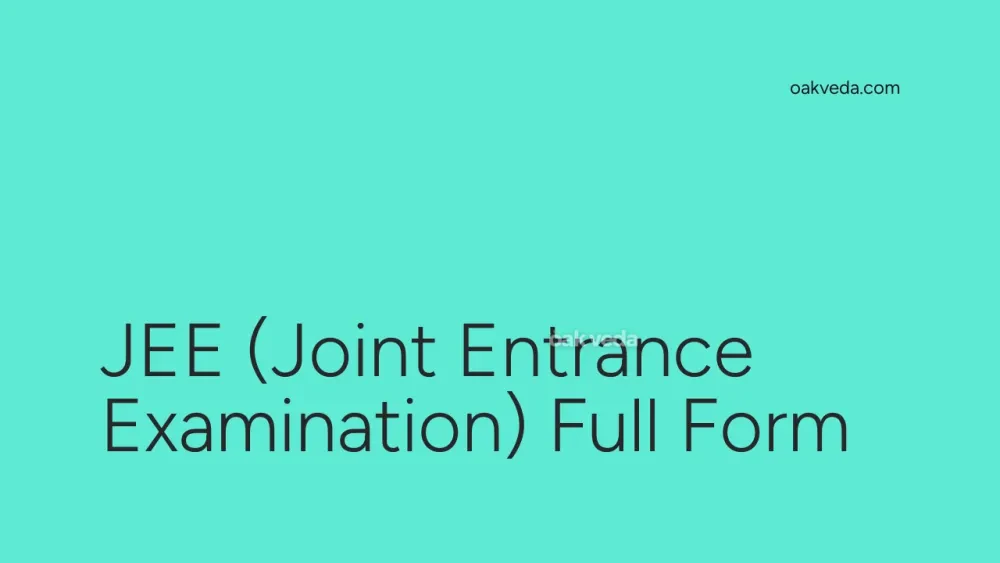
What is the Full Form of JEE?
The full form of JEE is Joint Entrance Examination. This national-level engineering entrance exam is conducted annually across India, serving as a gateway for aspiring engineers to secure admission in prestigious technical institutions.
What is Joint Entrance Examination?
The Joint Entrance Examination, commonly known as JEE, is a comprehensive assessment designed to evaluate students' aptitude for engineering disciplines. It plays a crucial role in determining admissions to various engineering colleges in India, including the renowned Indian Institutes of Technology (IITs) and National Institutes of Technology (NITs).
Origin and Development of Joint Entrance Examination
The JEE has evolved significantly since its inception. Initially, there were separate exams for different institutions. The All India Engineering Entrance Examination (AIEEE) was conducted for NITs and other centrally funded technical institutions, while the IIT-JEE was specifically for the IITs. In 2013, these exams were merged to form the current JEE structure, consisting of two levels: JEE Main and JEE Advanced.
How does Joint Entrance Examination work?
The JEE is conducted in two stages:
-
JEE Main: This is the first level of the examination, serving as a screening test for JEE Advanced and as the main admission test for NITs and other centrally funded technical institutions.
-
JEE Advanced: This is the second and more challenging level, specifically for admission to the IITs.
Students must clear JEE Main to be eligible for JEE Advanced. The National Testing Agency (NTA) conducts JEE Main, while JEE Advanced is organized by the IITs on a rotational basis.
Types of Joint Entrance Examination
The JEE consists of two main types:
-
JEE Main: This exam is conducted twice a year and consists of two papers:
- Paper 1: For B.E./B.Tech programs
- Paper 2: For B.Arch/B.Planning programs
-
JEE Advanced: This is a more rigorous exam conducted once a year for admission to IITs.
Functions of Joint Entrance Examination
The primary functions of JEE are:
- To assess students' aptitude in Physics, Chemistry, and Mathematics
- To serve as a common entrance test for multiple engineering institutions
- To maintain a standardized evaluation process across the country
- To identify and nurture top engineering talent in India
Applications of Joint Entrance Examination
JEE scores are used for:
- Admission to undergraduate engineering programs in IITs, NITs, and other participating institutions
- Determining eligibility for various scholarships and grants
- Assessing candidates' readiness for advanced engineering education
Features of Joint Entrance Examination
Key features of JEE include:
- Computer-based testing format
- Multiple choice questions (MCQs) and numerical value-based questions
- Negative marking for incorrect answers
- Bilingual question papers (English and Hindi)
- Standardized syllabus covering Physics, Chemistry, and Mathematics
Benefits of Joint Entrance Examination
- Provides a fair and standardized assessment for engineering admissions
- Offers multiple attempts to improve scores (for JEE Main)
- Enables students to compete for seats in top engineering institutions across India
- Prepares students for rigorous engineering curricula
Limitations or Challenges of Joint Entrance Examination
- High competition and stress levels among students
- Potential for coaching dependency
- Limited focus on practical skills and creativity
- Challenges in maintaining exam security and preventing malpractices
Future Developments in Joint Entrance Examination Technology
The JEE is continuously evolving to improve its effectiveness and fairness. Some potential future developments include:
- Adaptive testing methods
- Integration of artificial intelligence for more comprehensive assessment
- Inclusion of aptitude and personality evaluation components
- Enhanced security measures using biometric authentication
FAQs on JEE Full Form
-
What is the eligibility criteria for JEE Main? Candidates must have passed or be appearing in Class 12 (or equivalent) with Physics, Chemistry, and Mathematics as compulsory subjects. The minimum aggregate score required is 75% (65% for SC/ST candidates) in the qualifying examination.
-
How many attempts are allowed for JEE Main and Advanced? For JEE Main, candidates can attempt the exam twice in a year for three consecutive years. For JEE Advanced, candidates are allowed only two attempts in two consecutive years.
-
Is JEE conducted only in English? No, JEE Main is conducted in English, Hindi, and several regional languages. However, JEE Advanced is conducted only in English and Hindi.
-
What is the exam pattern for JEE Main? JEE Main consists of 90 questions (30 each from Physics, Chemistry, and Mathematics) to be answered in 3 hours. The exam includes both MCQs and numerical value-based questions.
-
How is the JEE Advanced different from JEE Main? JEE Advanced is more challenging and in-depth compared to JEE Main. It focuses on testing conceptual understanding and problem-solving skills at a higher level. Only the top-ranking candidates from JEE Main are eligible to appear for JEE Advanced.
In conclusion, the Joint Entrance Examination (JEE) plays a pivotal role in shaping the future of engineering education in India. As a comprehensive and challenging assessment, it continues to evolve, striving to identify and nurture the best engineering talent in the country.
You may be interested in:

